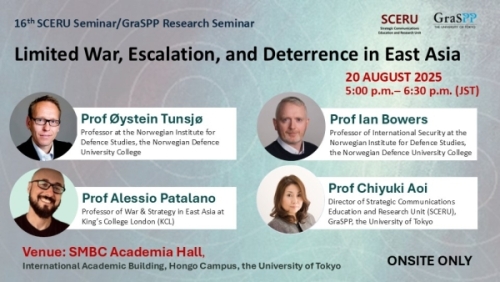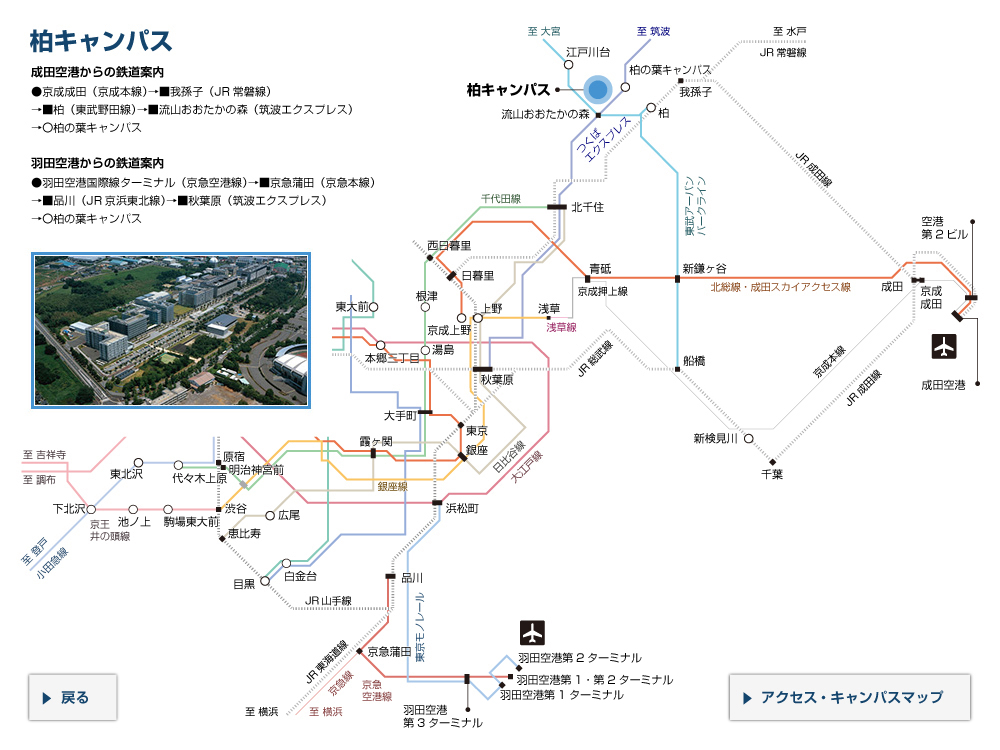16th SCERU Public Seminar

基本情報
| 区分 | 講演会等 |
|---|---|
| 対象者 | 社会人・一般 / 在学生 / 留学生 / 卒業生 / 企業 / 高専生 / 大学生 / 教職員 |
| 開催日(開催期間) | 2025年8月20日 17時 — 18時30分 |
| 開催場所 | 本郷地区 |
| 会場 | 東京大学本郷キャンパス 国際学術総合研究棟 4階 SMBCアカデミアホール |
| 参加費 |
無料
|
| 申込方法 | 要事前申込
Registration Form |
| 申込受付期間 | 2025年7月24日 — 2025年8月20日 |
| お問い合わせ先 | Strategic Communications Education and Research Unit SCERU事務局 sceru<at*>pp.u-tokyo.ac.jp * Change at to @. |
東京大学公共政策大学院(GraSPP)および戦略コミュニケーション教育研究ユニット(SCERU)主催セミナー
「東アジアにおける限定戦争、エスカレーションと抑止力
"Limited War, Escalation, and Deterrence in East Asia"」
* 会場は午後4時40分に開場します。
* このイベントは現地開催のみです。オンライン配信はありません。
* 入館の際は、セキュリティ上の理由により身分証明書をご持参ください。
* 言語:英語
概要:
This seminar brings together leading experts on East Asian security to examine the dynamics of limited conflict, escalation risks, and deterrence in the maritime domain of East Asia. The discussion focuses on the interplay between major power rivalry, operational realities at sea, and the ambiguous space between peace and war. In addition, attention is given to the meaning and significance of strategic communications in relation to coercion and deterrence within the “grey zone.”
This seminar provides a comprehensive look at the evolving security landscape in East Asia, offering insights into the operational, technical, and geopolitical dimensions of contemporary conflict and competition.
パネル討論:
1. The U.S.-China Stability-Instability Paradox: Limited War in East Asia
米中関係の安定・不安定パラドックスー東アジアにおける限定戦争
Øystein Tunsjø, Professor, Norwegian Institute for Defence Studies
With China and the United States seemingly locked in intensifying and enduring competition, many analysts compare today’s U.S.-China rivalry to the one between the Soviet Union and the United States during the Cold War. This article draws on the stability-instability paradox to compare the prospects for limited war in these scenarios. We identify two factors — geography and technology — that affect the likelihood of the paradox leading to conflict. Whether strategic nuclear stability increases or decreases the likelihood of limited conflict likely depends on how each side in a conflict dyad regards the prospects for limiting a conflict. (The presentation is based upon a co-authored journal article with Henrik Stålhane Hiim, forthcoming in International Security)
2. Contested Waters, Presence, and the Risk of Escalation in Maritime East Asia
東アジアにおける係争海域、プレゼンスとエスカレーションへのリスク
Ian Bowers, Professor of International Security, Norwegian Institute for Defence Studies
This presentation explores the risk of escalating conflict in maritime East Asia with a focus on the presence of adversarial navies and maritime law enforcement organisations in contested waters. It argues that such interactions at sea while raising the risk of localised conflict are unlikely to result in wider conflict escalation. However, the context of such interactions including the level of power symmetry between the actors on a local tactical and strategic level and the location of clashes play an important role in determining the risk of wider escalation.
3. Fifty Shades of Grey or Blends of Hybrid War? Conflict in the Age of Contestation
曖昧性への問い:グレーゾーンとハイブリッド戦の在り方ー 異存・対立の時代における紛争
Alessio Patalano, Professor of War & Strategy in East Asia, King’s College London
This presentation explores the increasing gap between peace and war. It suggests that, whilst wars —as a complex national and societal endeavour with a clearly defined legal construct —are becoming less frequent, military operations, robust forms of coercive action, and intense bursts of fighting are becoming increasingly common as currency in the management of international affairs. In this fractured and contested context, there remains considerable ambiguity about how to differentiate grey zone coercion and hybrid actions. The presentation argues that this lack of clarity invites probing, testing, and further escalation, rather than deterring their use.
4. Strategic Communications and Ambiguity in Grey Zone Deterrence
戦略的コミュニケーションとグレーゾーン抑止力をめぐる曖昧性
Chiyuki Aoi, Director of Strategic Communications Education and Research Unit (SCERU), GraSPP, The University of Tokyo
In this presentation, strategic communications is understood as the long-term shaping and shifting of dominant discourses within societies, taking a holistic approach grounded in liberal values and fundamental freedoms. Rather than focusing on short-term, reactive exchanges or tactical messaging, the emphasis is on fostering credibility, consistency, and adaptability to counter incremental coercion and support regional stability. The presentation highlights the importance of strategic communications in influencing the security environment and addressing adversaries’ efforts to exploit ambiguity through legal and normative manipulation, ensuring clarity of purpose and intent in the face of such challenges.
登壇者の略歴
「東アジアにおける限定戦争、エスカレーションと抑止力
"Limited War, Escalation, and Deterrence in East Asia"」
* 会場は午後4時40分に開場します。
* このイベントは現地開催のみです。オンライン配信はありません。
* 入館の際は、セキュリティ上の理由により身分証明書をご持参ください。
* 言語:英語
概要:
This seminar brings together leading experts on East Asian security to examine the dynamics of limited conflict, escalation risks, and deterrence in the maritime domain of East Asia. The discussion focuses on the interplay between major power rivalry, operational realities at sea, and the ambiguous space between peace and war. In addition, attention is given to the meaning and significance of strategic communications in relation to coercion and deterrence within the “grey zone.”
This seminar provides a comprehensive look at the evolving security landscape in East Asia, offering insights into the operational, technical, and geopolitical dimensions of contemporary conflict and competition.
パネル討論:
1. The U.S.-China Stability-Instability Paradox: Limited War in East Asia
米中関係の安定・不安定パラドックスー東アジアにおける限定戦争
Øystein Tunsjø, Professor, Norwegian Institute for Defence Studies
With China and the United States seemingly locked in intensifying and enduring competition, many analysts compare today’s U.S.-China rivalry to the one between the Soviet Union and the United States during the Cold War. This article draws on the stability-instability paradox to compare the prospects for limited war in these scenarios. We identify two factors — geography and technology — that affect the likelihood of the paradox leading to conflict. Whether strategic nuclear stability increases or decreases the likelihood of limited conflict likely depends on how each side in a conflict dyad regards the prospects for limiting a conflict. (The presentation is based upon a co-authored journal article with Henrik Stålhane Hiim, forthcoming in International Security)
2. Contested Waters, Presence, and the Risk of Escalation in Maritime East Asia
東アジアにおける係争海域、プレゼンスとエスカレーションへのリスク
Ian Bowers, Professor of International Security, Norwegian Institute for Defence Studies
This presentation explores the risk of escalating conflict in maritime East Asia with a focus on the presence of adversarial navies and maritime law enforcement organisations in contested waters. It argues that such interactions at sea while raising the risk of localised conflict are unlikely to result in wider conflict escalation. However, the context of such interactions including the level of power symmetry between the actors on a local tactical and strategic level and the location of clashes play an important role in determining the risk of wider escalation.
3. Fifty Shades of Grey or Blends of Hybrid War? Conflict in the Age of Contestation
曖昧性への問い:グレーゾーンとハイブリッド戦の在り方ー 異存・対立の時代における紛争
Alessio Patalano, Professor of War & Strategy in East Asia, King’s College London
This presentation explores the increasing gap between peace and war. It suggests that, whilst wars —as a complex national and societal endeavour with a clearly defined legal construct —are becoming less frequent, military operations, robust forms of coercive action, and intense bursts of fighting are becoming increasingly common as currency in the management of international affairs. In this fractured and contested context, there remains considerable ambiguity about how to differentiate grey zone coercion and hybrid actions. The presentation argues that this lack of clarity invites probing, testing, and further escalation, rather than deterring their use.
4. Strategic Communications and Ambiguity in Grey Zone Deterrence
戦略的コミュニケーションとグレーゾーン抑止力をめぐる曖昧性
Chiyuki Aoi, Director of Strategic Communications Education and Research Unit (SCERU), GraSPP, The University of Tokyo
In this presentation, strategic communications is understood as the long-term shaping and shifting of dominant discourses within societies, taking a holistic approach grounded in liberal values and fundamental freedoms. Rather than focusing on short-term, reactive exchanges or tactical messaging, the emphasis is on fostering credibility, consistency, and adaptability to counter incremental coercion and support regional stability. The presentation highlights the importance of strategic communications in influencing the security environment and addressing adversaries’ efforts to exploit ambiguity through legal and normative manipulation, ensuring clarity of purpose and intent in the face of such challenges.
登壇者の略歴






